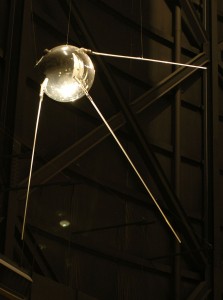Good morning, Whitewater.
Sunday in the Whippet City will be cloudy with a high of fifty-nine. Sunrise is 6:56 and sunset 6:30, for 11h 34m 22s of daytime. The moon is a waning gibbous with 53.9% of its visible disk illuminated.
Friday’s FW poll asked when a public school should suspend a student for wearing the wrong shade of green in a dress code. The overwhelming majority (92.31%) of respondents voted against suspension in these circumstances.
On this day in 1957, the Soviets launch an artificial satellite into orbit:
The Sputnik rocket was launched on 4 October 1957 at 19:28:34 UTC (5 October at the launch site[1]) from Site No.1 at NIIP-5.[54] Telemetry indicated the side boosters separated 116 seconds into the flight and the core-stage engine shut down 295.4 seconds into the flight.[52] At shut down, the 7.5 tonne core stage with PS-1 attached had attained an altitude of 223 km (139 mi) above sea level, a velocity of 7,780 m/s (25,500 ft/s) and velocity vector inclination to the local horizon of 0 degrees 24 minutes. This resulted in an initial orbit of 223 kilometres (139 mi) by 950 kilometres (590 mi), with an apogee approximately 500 kilometres (310 mi) lower than intended, and an inclination of 65.1 degrees and a period of 96.2 minutes.[52]
19.9 seconds after engine cut-off, PS-1 separated from the second stage[1] and the satellite’s transmitter was activated. These signals were detected at the IP-1 station by Junior Engineer-Lieutenant V.G. Borisov, where reception of Sputnik’s “beep-beep-beep” tones confirmed the satellite’s successful deployment. Reception lasted for two minutes, until PS-1 fell below the horizon.[29][55] The Tral telemetry system on the R-7 core stage continued to transmit and was detected on its second orbit.[1]
The designers, engineers and technicians who developed the rocket and satellite watched the launch from the range.[56] After the launch they drove to the mobile radio station to listen for signals from the satellite.[56] They waited about 90 minutes to ensure that the satellite had made one orbit and was transmitting, before Korolyov called Soviet premier Nikita Khrushchev.[57]
On the first orbit the Telegraph Agency of the Soviet Union (TASS) transmitted: “As result of great, intense work of scientific institutes and design bureaus the first artificial Earth satellite has been built”.[58] The R-7 core stage, with a mass of 7.5 tonnes and a length of 26 meters, also reached Earth orbit and was visible from the ground at night as a first magnitude object following the satellite. Deployable reflective panels were placed on the booster in order to increase its visibility for tracking.[57] The satellite itself, a small, highly polished sphere, was barely visible at sixth magnitude, and thus more difficult to follow optically. A third object, the payload fairing, also achieved orbit.
The core stage of the R-7 remained in orbit for two months until 2 December 1957, while Sputnik 1 orbited until 4 January 1958, having completed 1,440 orbits of the Earth.[1]
On this day in 1862, Wisconsinites participate in the Union defense of Corinth, Mississippi (a city having been taken previously by Federal soldiers):
The Second Battle of Corinth began when Confederate forces attempted to retake Corinth, Mississippi. The 8th, 14th, 16th, 17th and 18th Wisconsin Infantry regiments, along with the 6th and 12th Wisconsin Light Artillery batteries, fought to protect the city from Confederate troops. The Union general in charge cited the 14th Wisconsin Infantry for heroic service at Corinth, calling it “the regiment to rely upon in every emergency; always cool, steady, and vigorous.” The 17th Wisconsin Infantry was composed mainly of Irish immigrants. They led a bayonet charge with the Gaelic battle cry “Faugh a ballaghl” (“Clear the way!”), which the same general called, “the most glorious charge in the campaign.”

